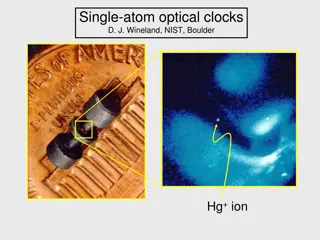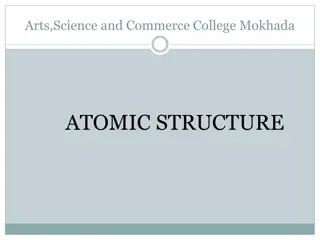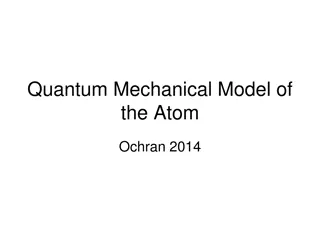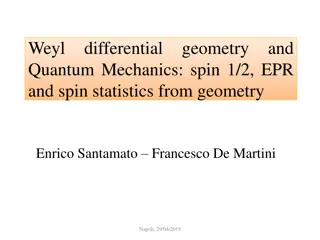Evolution of Atomic Models: From Ancient Philosophers to Quantum Mechanics
Tracing the evolution of atomic models from the ancient Greek philosophers' concept of indivisible atoms to the groundbreaking discoveries of electrons, protons, and neutrons. The journey through Thomson's Plum Pudding model, Rutherford's planetary model, Bohr's quantized model, and the introduction of quantum mechanics to explain atomic phenomena.
Uploaded on Sep 26, 2024 | 0 Views
Download Presentation

Please find below an Image/Link to download the presentation.
The content on the website is provided AS IS for your information and personal use only. It may not be sold, licensed, or shared on other websites without obtaining consent from the author. Download presentation by click this link. If you encounter any issues during the download, it is possible that the publisher has removed the file from their server.
E N D
Presentation Transcript
Advanced Higher Physics Introduction to Quantum Mechanics
History Phenomena observed in early 20thcentury did not follow classical physical laws New theories were developed to account for these phenomena Starting point taken as atomic structure
Atomic Models 1 - Ancients Atom is derived from Greek ~ a meaning not (like prefix un-) tom meaning cut Greek philosophers thought that atoms were the smallest possible things, and therefore indivisible unable to be cut This theory was widely accepted to be true until the late 19thcentury
Atomic Models 2 - Thomson 1897 Thomson s discovery of electron leads to Plum Pudding model Large positive mass with randomly arranged negative charges
Atomic Models 3 - Rutherford 1909 - Scattering experiment not consistent with Thomson model Rutherford postulated nucleus containing positive charges with electrons in orbits like planets
Atomic Models 3 (cont.) Later work lead to the discovery of The proton (Rutherford -1919) The neutron (Chadwick 1932)
Atomic Models 4 - Bohr Rutherford model still unable to explain spectral lines associated with emission of light from atoms
Atomic Models 4 (cont.) Bohr s model has electrons in orbit around a central nucleus, but allows only certain orbits for electrons. For stable orbit, angular momentum must be a multiple of h / 2 Angular momentum of electrons is quantised mvr = nh 2 n, is order of electron level
Atomic Models 4 (cont.) Reasons for electron stability related to De Broglie wavelength n = 6 Treating the orbit of an electron as a continuous wave, the path length (2 r) must be equal to a whole number of wavelengths i.e. n = 2 r Graphical Representation
Atomic Models 4 (cont.) h = From De Broglie equation, mv = 2 n nh r Combining with, = 2 r mv nh = mvr 2 nh = mvr 2
Atomic Models 4 (cont.) Angular momentum of electron in any orbit is always a multiple ofh / 2 This quantum of angular momentum is often expressed as ( h bar ), where = h / 2 Scholar Bohr Hydrogen Atom demo
Energy Levels For any quantum number, n, there exists a single orbit with a specific angular momentum, L = mvr, and energy, E, which can be calculated. Each quantum number, n, relates to an electron energy level, En, in the atom. When electrons move between energy levels they either absorb energy (excite) or emit energy (de-excite)
Spectral Lines 1 When an electron gains energy, by absorbing a photon, it rises to a higher energy level (excitation) When an electron loses energy, by emitting a photon, it falls to a lower energy level (de-excitation)
Spectral Lines 2 Hydrogen has a number of groups or series of line spectra, each for transitions to the same lower energy level. Scholar Hydrogen emission demo























